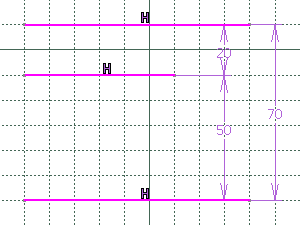More about Analyzing and Resolving Over-Constrained Sketches | |||||||
|
| ||||||
Over-constrained Sketches
In many sketches, the user will specify more than the minimum required number of dimensions or constraints. In certain cases the system will ignore redundant constraints and solve the Sketch. In other cases it will mark parts of the Sketch as over-constrained.
The descriptions below refer to consistent constraints and dimensions. Dimensions are said to be consistent if their values are satisfied by the position of the geometries.
Geometry will be marked as over-constrained when it cannot be solved because there are too many dimensions acting on it for the degrees of freedom available.
A dimension will be marked as over-dimensioned if it conflicts with one or more other dimensions and it is not possible to vary the value of the dimension and still find a consistent solution. For example, the geometry and dimensions in the figure below will be over-constrained because the dimension values cannot be varied independently, even though they can all be satisfied by appropriate geometry positions.

However, the system is able to cope with certain over-constrained situations involving logical constraints. This is important because logical constraints such as parallelism are likely to be over-specified when a design is being built up interactively. For example, if two lines are defined to be parallel and then a distance is subsequently given between them the parallelism is then specified twice.
The following is a list of some of the over-constrained
configurations that can be solved:
- Multiple constraints between the same geometries.
For instance, two circles can have several tangent constraints between them.
- Multiple coincident constraints between geometries of the same
type.
For instance, three points can each be made coincident to the other two.
- Multiple coincident constraints between lines and points.
For instance, two lines can be made coincident, and their endpoints can be made coincident with the other line.
Parallel and perpendicular constraints. Any combination of parallel and perpendicular constraints will be reduced to the minimum set required, and any excess ones will be ignored. Note that a distance dimension between two lines is treated as a parallel constraint, except that it will never be one of the constraints that is ignored.
Symmetric constraints. There are many configurations where symmetric constraints will make other constraints redundant. These are recognized by the system. For example, if two lines are made symmetric two of the coincidence constraints between the points and the lines are redundant.
![]()
Resolving Over-constrained Cases
Over-constrained entities occur in loops where all of the entities in a loop conflict with each other. Over-constrained entities can also occur when there are too many fixed geometries.
To resolve over-constrained problems, you need to:
- Set dimensions as references
- Deactivate or remove constraints
- Unfix geometry
Note that the system will evaluate as much of the geometry as possible. It determines exactly which dimensions are contributing to the situation.
![]()
Not Changed Status
The not changed status is used in the following cases:
- When geometry becomes over-constrained or inconsistent, the system will not be able to position any other geometries that depend on it. These dependent geometries and their associated dimensions (and any others that depend on them) will be marked not changed.
- Dimensions between two fixed geometry will be given the status code not changed.
- Dimension between two free or one free and one fixed geometry in the same set will be given the status code not changed.